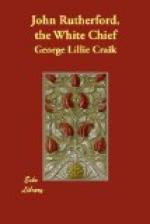Since the commencement of the intercourse of the New Zealanders with Europe, the sphere of their husbandry has been considerably enlarged by the introduction of several most precious articles which were formerly unknown to them. Cook, in the course of his several visits to the country, both deposited in the soil, and left with some of the most intelligent among the natives, quantities of such useful seeds as those of wheat, peas, cabbage, onions, carrots, turnips, and potatoes; but although he had sufficient proofs of the suitableness of the soil and climate to the growth of most of these articles, which he found that even the winter of New Zealand was too mild to injure, it appeared to him very unlikely that the inhabitants would be at the trouble to take care even of those whose value they in some degree appreciated. With the exception, in fact, of the turnips and potatoes, the vegetable productions which Cook took so much pains to introduce seem to have all perished. The potatoes, however, have been carefully preserved, and are said to have even improved in quality, being now greatly superior to those of the Cape of Good Hope, from which the seed they have sprung from was originally brought.
In more recent times, maize has been introduced into New Zealand; and the missionaries have sown many acres in the neighbourhood of the Bay of Islands, both on their own property and on that of the native chiefs, with English wheat, which has produced an abundant return.
Duaterra was the first person who actually reared a crop of this grain in his native country. On leaving Port Jackson the second time, to return home, he took with him a quantity of it, and much astonished his acquaintances by informing them that this was the very substance of which the Europeans made biscuits, such as they had seen and eaten on board their ships.
“He gave a portion of wheat,” says Marsden, “to six chiefs, and also to some of his own common men, and directed them all how to sow it, reserving some for himself and his uncle Shungie, who is a very great chief, his dominion extending from the east to the west side of New Zealand.
“All the persons to whom Duaterra had given the seed-wheat put it into the ground, and it grew well; but before it was well ripe, many of them grew impatient for the produce; and as they expected to find the grain at the roots of the stems, similar to their potatoes, they examined the roots, and finding there was no wheat under the ground, they pulled it all up, and burned it, except Shungie.
“The chiefs ridiculed Duaterra much about the wheat, and told him, because he had been a great traveller, he thought he could easily impose upon their credulity by fine stories; and all he urged could not convince them that wheat would make bread. His own and Shungie’s crops in time came to perfection, and were reaped and threshed; and though the natives were much astonished to find that the grain was produced at the top, and not at the bottom of the stem, yet they could not be persuaded that bread could be made of it.”




